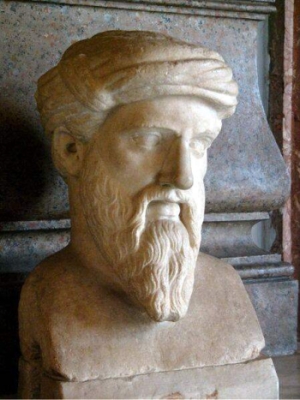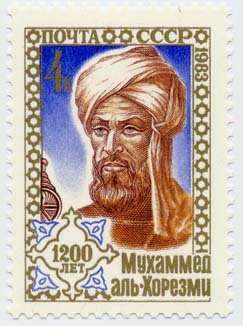
Editorial
This issue's Pluschat topics
- The Plus anniversary year — A word from the editors;
- Plus 10,000 — The best maths ever.
The Plus anniversary year — A word from the editors
This is the last issue of 2007 and, sadly, it's time to wrap up Plus's tenth birthday party. To celebrate our anniversary, we've been running a series on the best maths in history (see below), as well as articles by former editors on the history of Plus (see How time does PASS, Maths goes public and Plus leaves the classroom). But now it's time for the present editors to have their say.

Since 2005 Plus has been jointly edited by Rachel Thomas and Marianne Freiberger. Marc West is currently covering Rachel's maternity leave. When we took over from Helen Joyce Plus couldn't have been in better health. Most of what you see of Plus today had been put in place by Helen and previous staff, not least Rachel herself, who had already been working for Plus for quite a few years. Our main task lay in maintaining Plus's impressive legacy, but with technology continuing to race ahead, there has also been some room for innovation.
When Plus began, keeping the bandwidth to a minimum was a primary concern. But with many people now having high-speed internet access, we can exploit this beautiful medium to its full power. We've recently started to produce podcasts, enabling our readers to become listeners, take their maths on the move, and hear the lovely and generous Plus contributors speak for themselves. A faster internet also means that our articles can now be illustrated with beautiful mathematical imagery and interactive animations — see for example Non-Euclidean geometry and Indra's pearls and Understanding uncertainty: a league table lottery. And for those who want to interact with us and other Plus readers directly, there's the Plus blog.
But we're not entirely driven by technology. The strength of Plus has always been its content, for which we have our lovely and generous contributors to thank. Whether it is art, politics, science, leisure, medicine or hard maths, our authors have shown the excitement, creativity and vitality of mathematics. And with the launch last year of our annual writing competition, the Plus new writers award, we hope to support a new generation of popular maths authors. The competition is open to people from all ages and backgrounds and there's a separate category for school students. If you love maths and want to tell the world about it, then get writing now for the 2008 competition and your chance to join our list of acclaimed authors.
Students and their teachers have always been an important and treasured part of our audience. We know that in these busy times it's not always possible for teachers to search the web for those extra bits of information that add spice to their maths lessons, and so we have started to produce teacher packages. These bring together all the Plus content on particular curriculum subjects, together with handy links to problems on our sister site NRICH.
Another new feature on Plus, starting from this issue, is David Spiegelhalter's column Understanding uncertainty, which anticipates his own website to be launched in 2008. Spiegelhalter is Cambridge's Winton Professor of the Public Understanding of Risk and in his column he'll look at issues that concern all of us but confound many of us, including league tables and health scares.
Plus couldn't be what it is without its authors, but behind the scenes there is another, absolutely essential group of people: our sponsors. Without them Plus would be utterly impossible and we'd like to extend our warmest thanks to them. We'd also like to thank everyone working on the Millennium Mathematics Project of which Plus is a part. And finally, we'd like to thank you, our readers, for keeping us going for so long!
Plus 10,000 — The best maths ever
To celebrate the tenth anniversary year of Plus, we've been running a series on our favourite maths in history. In the March issue this year we covered the best maths of the last 10 years, in the June issue some of the best maths of the last 100 years, and in the September issue we looked at some interesting mathematical lives within the last 1,000 years.
In this issue we focus on the best maths of the last 10,000 years, which is pretty much the best maths of all time. The choice is overwhelming, but we picked out a few favourites:
- The place-value system;
- The Pythagoreans: all is number;
- More Greeks: Plato, Euclid and Archimedes;
- The father of algebra.
The place-value system

Roman numerals are still common on clocks.
Even the earliest humans must have had a basic understanding of numbers. In fact, today we know that small babies and even some animals have a grasp of numerosity: they can tell the difference between a set of three things and a set of four things, and if the things are tasty, they go for the latter. But the real challenge comes when you go beyond what you can understand instinctively or even visually. Pretty soon you need a way of writing things down. And that's the first challenge.
Two naive approaches to writing down numbers immediately spring to mind. Firstly, you could represent a number like 7777 by making 7777 marks on a piece of paper, or stone, or clay tablet, or in the sand. Secondly, you could invent a new symbol for every number. Both are pretty cumbersome, so most ancient civilisations, including the Egyptians, the Greeks and the Romans, used a mixture of the two. They chose a base number — ten in the decimal system — and used the first approach, repeating the same symbol, for counting up to the base number. That number would then have a new symbol. The numbers up to the next power of the base number would then again be formed by repetition and so on. For example, the Roman way of writing 1234 was MCCXXXIIII, where M stands for a thousand, C for a hundred, X for ten and I for one. (The Romans had a base ten system, but for convenience they also had separate symbols for multiples of five.)
Not a bad idea, but if you want to count all the way up to near infinity you need an infinite set of symbols. The great break-through here was the place-value system. You choose a base number, say ten, and invent a symbol for all the numbers from one up to nine. You express numbers by strings of these symbols, but the true value of each symbol depends on its position in the string: a 1 is a one if its all the way on the right, but it stands for a ten if it's in the second position from the right, for a hundred if it's in the third position from the right and so on. Problem solved.
It's widely believed that our modern numeral system was born in India some time between 100 CE and 900 CE, although the ancient Babylonians had a place-value number system (with a base sixty) around 2000 BCE and the Chinese also had one long before the Indians. The Indians, like the Chinese, but unlike the Babylonians, also had a symbol for denoting an empty slot in a string of numbers. This arises, for example, with the number ten because it's got no units to go into the right-most position. But whether or not the notion of zero as an actual number originated in India is disputed.
Related articles in Plus:
The Pythagoreans: all is number

A bust of Pythagoras in the Capitoline Museums, Rome. Image reproduced under the GNU free documentation licence.
The mathematics that comes down to us from most ancient cultures, including the Babylonians and the Egyptians, was clearly motivated by practical issues: people had to do their accounts and divide their land. But a dramatic shift had occurred by the time of Pythagoras of Samos (ca 580 BCE - 500 BCE) and his secret society, who elevated mathematics to the realms of philosophy and looked at it as the one true language of nature. In that sense, the Pythagoreans can be regarded as the true founders of modern mathematics. In fact, the very words "philosophy" (love of wisdom) and "mathematics" (that which is learned) are supposed to have been coined by Pythagoras to describe the intellectual activities pursued not for practical reasons, but for pure love and for the building of moral fibre.
The Pythagoreans' motto is said to have been "all is number". And by numbers they meant whole numbers and their ratios, the fractions. These numbers, to the Pythagoreans, were not just the building blocks of mathematics, but the atoms of the universe. Geometric shapes could be described by patterns of points — a triangle for example is defined by three points — and their subdivision by proportions. Since points can be counted and proportions represented by ratios of whole numbers, geometry became just a branch of arithmetic. Soon this led to the idea of an arithmetic of the heavens that describes the world and everything within it. Ten was the perfect number within this arithmetic because it was the embodiment of the spatial dimensions: one point generates geometry, two points define a one-dimensional line-segment, three points a two-dimensional triangle and four points that don't lie in a plane define the three-dimensional tetrahedron — and 1+2+3+4=10. The Pythagorean Philolaus wrote that the number ten was "great, all-powerful and all-producing, the beginning and the guide of the divine as of terrestrial life".
Several mathematical advances are attributed to the Pythagoreans, though original sources are scarce and unclear, so we can't say for certain who did what when. The golden section was routinely considered by the Pythagoreans, and they considered number sequences dictated by geometric shapes, for example the triangular numbers of the form n(n+1)/2. Pythagoras is said to have discovered that the sound made by vibrating strings sounds harmonious if the strings' length can be described by certain ratios. This is the first instance of someone describing simple laws of acoustics and led Pythagoras to the idea that the heavenly bodies also emitted harmonious tones, the music of the spheres. The theorem that still carries Pythagoras's name, incidentally, almost certainly came down to him from the Babylonians, though some have suggested that he encountered it on a trip to India.
The Pythagorean number rule was not destined to last. It was shattered, as we know from Plato's dialogues, by the discovery of irrational numbers and also by the paradoxes of Zeno. The diagonal of a square of side length one has length the square root of two. Now try as hard as you might, there is no way to express this length as a ratio of two whole numbers: the square root of two is irrational. It's unclear exactly when the irrationality of these numbers was first discovered — some have attributed it to early Hindu mathematicians — but it seems that the Pythagoreans first came across it after Pythagoras's death. Many have attributed the discovery to Hippasus of Metapontum, and legend has it that he was thrown overboard the ship he was on at the time as a punishment for his blasphemy.
Zeno of Elea (writing around 450 BCE) was a member of the rival order known as the Eleatics. While the Pythagoreans postulated that the numbers and their plurality were the essence of everything, the Eleatics held that it was not multiplicity, but unity that lay at the heart of all things. Zeno came up with a number of paradoxes which seemed to refute the view that things are divisible. The most famous one suggests that Achilles, no matter how fast he runs, will never be able to overtake a tortoise, no matter how slow it is. For whenever he has caught up with it, the tortoise has already moved along, even if only by a tiny distance. If you admit that space is infinitely divisible (and if you don't know about converging series) then you can deduce from this that Achilles never gets ahead of the tortoise, because the catching-up process happens infinitely many times.
Both the discovery of irrational numbers and Zeno's paradoxes devastated the Pythagorean tenet. Soon Greek mathematics favoured continuous geometric entities over discrete numbers — geometry started to rule.
Related articles in Plus:
- On the dissecting table;
- 101 uses of a quadratic equation;
- Mathematical mysteries: transcendental meditation;
- In perfect harmony;
- The origins of proof: Part III;
- Maths and magic;
- The magical mathematics of music;
- Chaos in numberland: the secret life of continued fractions;
- The mathematics of Fibonacci's sequence;
- The golden ratio and aesthetics;
- Natural frequencies and music;
- Why is the violin so hard to play?
- Self-similar syncopations;
- Mathematical mysteries: Zeno's paradoxes;
- Maths and art: the whistle stop tour;
- The life and numbers of Fibonacci;
More Greeks: Plato, Euclid and Archimedes

The school of Athens, a painting by Raphael, depicts a number of Greek philosophers, including Pythagoras, Plato, Euclid, Aristotle, Zeno and Archimedes. Find out who is thought to be who.
Greek mathematics, with geometry ruling supreme, continued to go strong in the age of Plato (427 BCE - 347 BCE), who famously inscribed the words "Let no-one ignorant of geometry enter here" over the door of his Athens academy. It was during Plato's time that the seven liberal arts — which included arithmetic, geometry and Zeno's dialectic reasoning — were set out, and they continued to dominate Western education systems for over 2000 years.
Plato did not contribute to mathematics itself, but we can attribute much of our modern philosophy of maths to him. He actively encouraged the study of mathematics for its own sake. He enforced the idea that mathematical objects should not be thought of as real things, but as ideal objects of the mind. And he made a sharp distinction between pure mathematics, which elevates the mind, and the mere solving of practical problems, which he relegated to the lowly realms of commerce. Both Plato and Aristotle (384 BCE - 322 BCE) helped to formalise mathematical reasoning.
The five Platonic solids are probably the most famous mathematical objects that carry Plato's name. They played an important role in Plato's world view, with the dodecahedron being the symbol of the universe, but it was probably his friend Theaetetus who proved that there were only five regular polyhedra and no more. Students and students of students of Plato's academy gave us the method of exhaustion, a forerunner of infinitesimal calculus, as well as the well-loved conic sections.
The most famous supposed students of Plato's academy must be Euclid of Alexandria (325 BCE - 265 BCE). His book The Elements is the most influential textbook of all time. Only religious texts like the bible can have gone through more editions and have had such a long-lasting effect.

A fragment of Euclid's Elements found at Oxyrhynchus and thought to date from around 100 CE.
Euclid's Elements is an introduction to arithmetic, geometry and a geometric form of algebra. What is most striking is its axiomatic approach and logical rigour. Without any introduction whatsoever, Euclid launches straight into a list of 23 definitions describing basic mathematical objects such as points, lines and planes. Following that are five postulates and five common notions, which in modern terms we'd consider as axioms: self-evident truths that require no further proof or explanation. In what follows Euclid aims to derive all of his results from those axioms, using only the rules of logic. There are quite a few holes in his arguments, they wouldn't pass a modern test, but they were perfectly acceptable to mathematicians for hundreds of years to come. Incidentally, Euclid's fifth postulate kept bugging mathematicians because it wasn't quite as obvious as the others, and this eventually led to the invention of non-Euclidean geometry almost 2000 years later. But flawed or not, Euclid's Elements was the first, and the longest-lived, exposition of modern mathematical methods ever.
Euclid was a teacher at Alexander the Great's famous school at Alexandria. Scholars believe that our next giant of mathematics — Archimedes of Syracuse (ca 287 BCE - 212 BCE) — was amongst his students. While Plato and his friends had been interested in the noble art of pure mathematics, Archimedes did not mind considering real things. He postulated the hydrostatic principle and found a new derivation of the law of the lever (and famously said that if only he had a lever and a fulcrum he could move the Earth). His approach was axiomatic and crisply logical and he is widely regarded as the father of mathematical physics.
Archimedes even stooped so low as to consider mere computation. In a boast that he could write down really large numbers, he estimated the number of grains of sand that would fill the whole universe (in the shape it was assumed to have then). His great talent for computation also enabled him to give an estimate of π that was more accurate than anything the Egyptians and Babylonians had come up with. In the process he nearly invented the logarithm.
But purer pursuits were also part of Archimedes's repertoire. Inspired by two famous problems of antiquity — the squaring of the circle and the trisection of the angle — he came up with the spiral that still carries his name. In fact, Archimedes seemed to like round things: he came up with area and volume calculations concerning the conic sections, cylinders and spheres. He made heavy use of the method of exhaustion and came excruciatingly close to integral calculus as we know it today.
Related articles in Plus:
- Euler's polyhedron formula;
- Imaging maths - unfolding polyhedra;
- How maths can make you rich and famous: Part II;
- The origins of proof;
- Mathematical mysteries: Strange geometries;
- Non-Euclidean geometry and Indra's pearls;
- Understanding turbulence;
- What is the area of a circle?
The father of algebra

Al-Khwarizmi as depicted on a USSR stamp.
What Euclid's Elements was to geometry, the Al-jabr wa'l muqahbalah by Mohammed ibn-Musa al-Khwarizmi (ca 790 CE - 840 CE) was to algebra. In fact, our modern word "algebra" derives from the title of this work. It's generally believed that the word originally meant something like "restoration" — in Don Quixote we come across an algebrista, who is a bone-setter, in other words a restorer of bones.
Al-Khwarizmi was a mathematician and astronomer at the House of wisdom, established in Baghdad by the caliph al-Mamun. The city soon became a second Alexandria and without the effort of Islamic scholars during the eighth and ninth centuries, much of the ancient maths that has come down to us would have been lost.
Al-Khwarizmi wasn't the first person to consider algebraic problems, Diophantus of Alexandria (ca 200 CE - 284 CE) is one notable ancient algebraist, but the Al-jabr was the first elementary, rigorous and systematic treatment of the subject. Al-Khwarizmi describes the solutions to all types of linear and quadratic equations that have positive roots (he didn't consider negative numbers at all) and he also gives geometric proofs.
What is also interesting about Al-jabr is its style: there are no symbols for unknown numbers or abbreviations of any kind. Al-Khwarizimi wrote out everything in words and whole sentences, even the numbers! Nevertheless, the essence of algebra is all there and that is what has gained him the title "father of algebra".